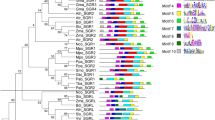Abstract
The possible hydrolytic activity towards chlorophyll molecules was predicted for DUF538 protein superfamily in plants. It was examined by using computational as well as experimental tools including in vitro chlorophyll degradation, antioxidant compounds production and in vivo real-time gene expression tests. Comparison of the computational data with the experimental results indicated that DUF538 proteins might be chlorophyll hydrolyzing enzyme (most probably carboxyesterase) which degrade chlorophyll molecules (66 % per 12 hrs) to produce new compounds (1.8 fold per 12 hrs) with antioxidant properties. The relevance of DUF538 gene expression level with the chlorophyll contents (2.8 fold increase per chlorophyll content of 50 %) of the drought-stressed leaves showed that chlorophyll degradation by DUF538 is most probably induced in response to stress stimuli. Despite membranous chlorophyll catabolic pathways, DUF538-dependent reactions is predicted to be occurred in the cytosol of the under stressed plants. We addressed as to whether chlorophyll breakdown to antioxidant compounds by DUF538 is a defense mechanism of plants against stress stimuli, in vivo? This question is going to be investigated in our next research project.





Similar content being viewed by others
Abbreviations
- DUF538:
-
Domain of unknown function
- NMR:
-
nuclear magnetic resonance
- BPI:
-
Bactericidal permeability increasing
- WSCP1:
-
Water soluble chlorophyll binding protein 1
- LPS:
-
Lipopolysaccharide
- ROS:
-
Reactive oxygen species
- MBP:
-
Maltose-binding protein
- IPTG:
-
Isopropyl β-D-thiogalactopyranoside
- EDTA:
-
Ethylenediaminetetracetic
- BME:
-
ß-mercaptoethanol
- BSA:
-
Bovine serum albumin
- NBT:
-
Nitro blue tetrazolium
- BCIP:
-
Bromo chloro indolyl phosphate
- DMF:
-
Dimethyl formamide
- FRAP:
-
Ferric reducing antioxidant power
- TPTZ:
-
Tripyridyl triazine
- RT-PCR:
-
Reverse transcriptase-polymerase chain reaction
References
Benzie FF, Strain JJ (1999) The ferric reducing ability of plasma as leisure of antioxidant power, the FRAP assay. Anal Biochem 239:70–76
Chairat B, Nutthachai P, Varit S (2013) Effect of UV-C treatment on chlorophyll degradation, antioxidant enzyme activities and senescence in Chinese kale (Brassica oleracea var. alboglabra). Int Food Res J 20:623–628
Eckardt NA (2009) A new chlorophyll degradation pathway. Plant Cell 21:700
Fang Z, Bouwkamp JC, Solomos T (1998) Chlorophyllase activities and chlorophyll degradation during leaf senescence in non-yellowing mutant and wild type of Phaseolus vulgaris L. J Exp Bot 49:503–510
Gholizadeh A (2011) Heterologous expression of stress-responsive DUF538 domain containing protein and its morpho-biochemical consequences. Protein J 30:351–358
Gholizadeh A (2014) Prediction of tertiary structure homology between bactericidal/permeability increasing protein of innate immune system and hydrolase enzymes. Int J Biosci 5:1–6
Gholizadeh A, Baghbankohnehrouz B (2010) Identification of DUF538 cDNA clone from Celosia cristata expressed sequences of none stressed and stressed leaves. Russ J Plant Physiol 57:247–252
Gholizadeh A, Baghbankohnehrouz S (2013) DUF538 protein super family is predicted to be the potential homologue of bactericidal/permeability-increasing protein in plant system. Protein J 32:163–171
Hörtensteiner S, Kräutler B (2011) Chlorophyll breakdown in higher plants. Biochim Biophys Acta 1807:977–988
Kariola T, Brader G, Li J, Palva ET (2005) Chlorophyllase 1, a damage control enzyme, affects the balance between defense pathways in plants. Plant Cell 17:282–294
Kura-Hotta M, Satoh K, Katoh S (1987) Relationship between photosynthesis and Chl content during leaf senescence of rice seedlings. Plant Cell Physiol 28:1321–1329
Laemmli UK (1970) Cleavage of structural proteins during the assembly of the head of bacteriophage T4. Nature 227:680–685
Larson RA (1988) The antioxidants of higher plants. Phytochem 27:969–978
Livak KJ, Schmittgen TD (2001) Analysis of relative gene expression data using real-time quantitative PCR and the 2–ΔΔCt method. Methods 25:402–408
Majumdar S, Ghosh S, Glick BR, Dumbroff EB (1991) Activities of chlorophyllase, phosphoenolpyruvate carboxylase and ribulose-1,5-bisphosphate carboxylase in the primary leaves of soybean during senescence and drought. Physiol Plant 81:473–480
Moran R (1982) Formulae for determination of chlorophyllous pigments extracted with N,N-dimethylformamide. Plant Physiol 69:1376–1381
Nakagami H, Sugiyama N, Mochida K, Daudi A, Yoshida Y, Toyoda T, Tomita M, Ishihama Y, Shirasu K (2010) Large-scale comparative phosphoproteomics identifies conserved phosphorylation sites in plants. Plant Physiol 153:1161–1174
Ni X, Quisenberry SS, Markwell JP, Heng-Moss P, HigleyLG (2001) In vitro enzymatic chlorophyll catabolism in wheat elicited by cereal aphid feeding. Entomo Exp et Appl 101:159–166
Noguchi T, Kamimura Y, Inoue Y, Itoh S (1999) Photoconversion of a water-soluble chlorophyll protein from Chenopodium album: resonance Raman and Fourier transform infrared study of protein and pigment structures. Plant Cell Physiol 40:305–310
Roberts MR, Paul ND (2006) Seduced by the dark side: integrating molecular and ecological perspectives on the influence of light on plant defense against pests and pathogens. New Phytol 170:677–699
Saleh L, Plieth C (2009) Fingerprinting antioxidative activities in plants. Plant Methods 5:2
Satoh H, Uchida A, Nakayama K, Okada M (2001) Water-soluble chlorophyll protein in brassicaceae plants is a stress-induced chlorophyll-binding protein. Plant Cell Physiol 42:906–991
Schenk N, Schelbert S, Kanwischer M, Goldschmidt EE, Dörmann P, Hörtensteiner S (2007) The chlorophyllases AtCLH1 and AtCLH2 are not essential for senescence-related chlorophyll breakdown in Arabidopsis thaliana. FEBS Lett 27:5517–5525
Takahashi S, Yoshikawa M, Kamada A, Ohtsuki T, Uchida A, Nakayama K, Satoh H (2013) The photoconvertible water-soluble chlorophyll-binding protein of Chenopodium album is a member of DUF538, a superfamily that distributes in embryophyta. J Plant Physiol 170:1549–1552
Trebitsh T, Goldschmidt EE, Riov J (1993) Ethylene induces de novo synthesis of chlorophyllase, a chlorophyll degrading enzyme, in citrus fruit peel. Proc Natl Acad Sci U S A 15:9441–9445
Acknowledgments
The author of this paper is thankful to the Research Institute for Fundamental Sciences (RIFS), University of Tabriz for the financial support.
Author information
Authors and Affiliations
Corresponding author
Appendix
Appendix
Figure 6
Analysis of DUF538 distribution in nature. Ortholog cluster was analyzed by OC server at www.genome.ad.jp. Organisms sequence include Eudicots, Monocots, Basal Magnoliophyta, Ferns and Mosses
Rights and permissions
About this article
Cite this article
Gholizadeh, A. DUF538 protein superfamily is predicted to be chlorophyll hydrolyzing enzymes in plants. Physiol Mol Biol Plants 22, 77–85 (2016). https://doi.org/10.1007/s12298-015-0331-1
Received:
Revised:
Accepted:
Published:
Issue Date:
DOI: https://doi.org/10.1007/s12298-015-0331-1





